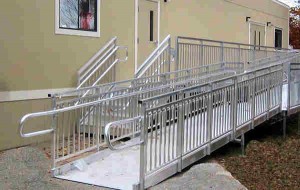Why build an access solution for your site-built or modular building from scratch? REDD Team’s aluminum building ramps are strong, ADA-compliant, virtually maintenance-free, and extremely cost-effective. We offer universal designs in a variety of sizes and dimensions, as well as custom configurations to meet any requirement.
 When wood and masonry are exposed to changing weather conditions, they respond by absorbing water, rotting, cracking, warping or breaking, creating safety hazards if neglected. Aluminum, on the other hand, doesn’t absorb water and won’t rust, rot or crack. Its natural oxide coating protects it from corrosion, which is a huge advantage in marine environments. It’s also impervious to termites and other pests that wreak havoc on wood.
When wood and masonry are exposed to changing weather conditions, they respond by absorbing water, rotting, cracking, warping or breaking, creating safety hazards if neglected. Aluminum, on the other hand, doesn’t absorb water and won’t rust, rot or crack. Its natural oxide coating protects it from corrosion, which is a huge advantage in marine environments. It’s also impervious to termites and other pests that wreak havoc on wood.
As for strength, aluminum is about three times heavier than wood, but also three times stronger, so an aluminum tube is capable of withstanding a very large load and weighs very little in comparison to a solid wood board of the same strength. This strength-to-weight ratio makes aluminum exceptionally useful for mobile stairs and ramps because they are easy to move. Steel is stronger than aluminum, but also three times heavier.
Ramps made of wood or steel also require regular scraping, sanding, painting and sealing to keep them in safe, usable condition. Aluminum requires no finishing at all and will maintain its appearance for a lifetime. However, it can be anodized, painted or powder-coated if desired.
ADA Ramp Standards
Ramps are the most common way to address access issues for people who use wheelchairs, scooters, or who struggle with stairs. REDD Team’s universal aluminum ramps are perfect for any location and they comply with ADA Standards. What follows is a summary of the regulations; we encourage you to review the complete ADA standards.
- Ramp runs must have a running slope no steeper than 1:12; however, there are exceptions for existing buildings that have space limitations.
- The cross slope of ramp runs must be no steeper than 1:48.
- No other changes in level aside from the running slope and cross slope are permitted on ramp runs.
- The rise for any ramp run must be a maximum of 30 inches.
- The clear width of a ramp run and, where handrails are provided, the clear width between handrails must be a minimum of 36 inches.
- Ramps must have landings at the top and the bottom of each ramp run.
- Ramp runs with a rise greater than 6 inches must have handrails; however, there are exceptions for certain employee work areas.
- The floor or ground surface of the ramp run or landing must extend at least 12 inches beyond the inside face of a handrail to prevent wheelchair casters and crutch tips from slipping off the ramp surface.
- Edge protection must be provided on each side of ramp runs and at each side of ramp landings.
- Landings exposed to wet conditions must be designed to prevent the accumulation of water.
Our universal ramp systems meet all ADA standards, as well as IBC, SBC, BOCA, SREF, UBC and Life Safety 101 code requirements.
REDD Team offers a complete line of products, including modular ramps, portable ramps, pedestrian bridges and walkway systems, crossover stairs, and aluminum viewing platforms that will fit your budget.
We have the expertise to assess and measure your building or other property for ramps and other access solutions. Get in touch with us at (800) 648-3696 to find out how our aluminum access solutions can meet your needs.

